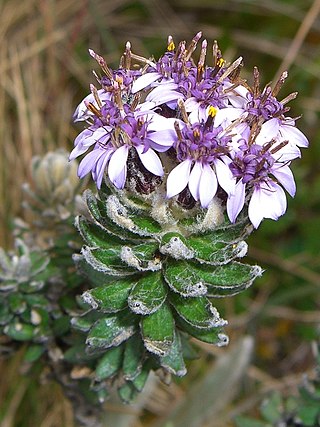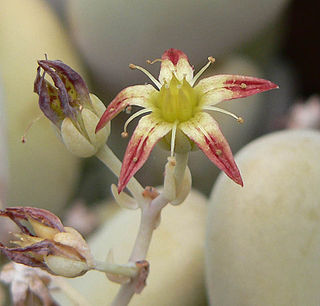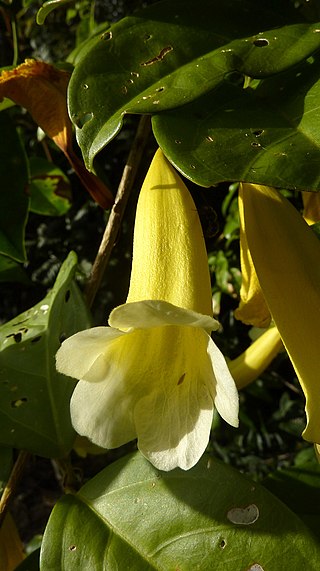
Petalostigma is a genus of plants under the family Picrodendraceae and the monogeneric subtribe Petalostigmatinae, first defined by von Mueller in 1857. It is native to New Guinea and Australia. They are evergreen, dioecious shrubs or trees.

Illicium is a genus of flowering plants treated as part of the family Schisandraceae, or alternately as the sole genus of the Illiciaceae. It has a disjunct distribution, with most species native to eastern Asia and several in parts of North America, including the southeastern United States, Mexico, and the Caribbean. General common names include star anise and anisetree. The genus name comes from the Latin illicere.

Diplostephium is a genus of trees and shrubs in the family Asteraceae.

Osmoxylon is a genus of flowering plants in the family Araliaceae.

Dialium is a genus of flowering plants in the family Fabaceae, subfamily Dialioideae. Velvet tamarind is a common name for several species.
Polyalthia pachyphylla is a species of plant in the family Annonaceae. It is a tree endemic to Peninsular Malaysia.
Rhaptopetalum is a genus of plants in the family Lecythidaceae.

Vincetoxicum is a genus of plants in the family Apocynaceae. Although the species in Vincetoxicum have sometimes been included in Cynanchum, chemical and molecular evidence shows that Vincetoxicum is more closely related to Tylophora, now included in Vincetoxicum. The generic name means "poison-beater" in Botanical Latin because of the plants' supposed antidotal effects against snakebite.
Xylosma pachyphylla, commonly known as spiny logwood, is a species of flowering plant in the family Salicaceae, that is endemic to Puerto Rico. It can be found in forests on the island's western mountains, where it grows in serpentine soils. It is threatened by habitat loss.

Graptopetalum (leatherpetal) is a plant genus of the family Crassulaceae. They are perennial succulent plants and native to Mexico and Arizona. They grow usually in a rosette. There are around 19 species in this genus.

Sedum rubrotinctum or Sedum × rubrotinctum, and commonly known as jelly-beans, jelly bean plant, or pork and beans. It is a species of Sedum from the plant family Crassulaceae. It is a succulent plant originating in Mexico.

Psacalium is a genus of flowering plants in the sunflower family. Indianbush is a common name for Psacalium.

Podachaenium is a genus of Mesoamerican plants in the tribe Heliantheae within the family Asteraceae.

Anemopaegma is a genus of flowering plants in the family Bignoniaceae. Species of Anemopaegma along with many other unrelated plants go by the name of catuaba.

Homalopetalum is a genus of flowering plants from the orchid family, Orchidaceae. It contains 8 known species native to Central America, northern South America, Mexico and the West Indies.
- Homalopetalum alticola(Garay & Dunst.) Soto Arenas - Venezuela
- Homalopetalum hypoleptum(Lindl.) Soto Arenas - Brazil
- Homalopetalum kienastii(Rchb.f.) Withner - Mexico
- Homalopetalum leochilus(Rchb.f.) Soto Arenas - Cuba, Dominican Republic
- Homalopetalum pachyphyllum(L.O.Williams) Dressler - Mexico
- Homalopetalum pumilio(Rchb.f.) Schltr. - Mexico, Central America, Ecuador
- Homalopetalum pumilum(Ames) Dressler - Mexico
- Homalopetalum vomeriforme(Sw.) Fawc. & Rendle - Cuba, Jamaica

Dysoxylum pachyphyllum is a small tree in the family Meliaceae, endemic to Lord Howe Island. It grows at all altitudes on the island, up to 15 metres tall.

Sarcophyton is a genus of flowering plants from the orchid family, Orchidaceae. It has three known species, native to Taiwan and the Philippines:
Coptosperma is a genus of flowering plants in the family Rubiaceae. It contains 19 species native to Africa, the Arabian Peninsula, and various islands of the Indian Ocean.
Leptopetalum is a genus of flowering plants in the family Rubiaceae. The genus is widespread in tropical and subtropical Asia and the Pacific.













